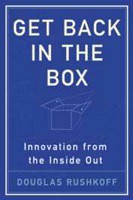Open Source & Architecture - Take 1
 In his blog recently, Douglas Rushkoff has pre-published some interesting thoughts on how open-source attitudes, habits, and mentalities are now finding purchase in mainstream design practices. The following quote about his "authorship society", also quoted here, documents some of these observations...
In his blog recently, Douglas Rushkoff has pre-published some interesting thoughts on how open-source attitudes, habits, and mentalities are now finding purchase in mainstream design practices. The following quote about his "authorship society", also quoted here, documents some of these observations...It is the real legacy of the open source movement -- misunderstood even by many of its participants as solely a way to develop computer operating systems, and underestimated in its potential impact by even its staunchest opponents. As I've come to see it, the deeper cultural agenda is based on three far-reaching assumptions:... Astute readers of California architect Wes Jones's 1990's texts will have heard echoess of his Corb-riffing thoughts in this. Specifically, in Instrumental Form: Designs for Words, Buildings, Machines Mr. Jones has an essay on "bossness" that is careful to detail the American approach to cars (hotrod) vs. the European mentality (Ferrari) -- where us Yankees feel free to paint flames on, and tinker under the hood of what Europeans would only hire skilled technicians to do.
1. The systems by which we live are inventions and conventions.
2. The codes underlying those systems can be learned and rewritten.
3. This process best takes place collaboratively.
It's those same three stages of renaissance we've been looking at all along: moving from passivity to gaining a perspective and then to attaining the power of authorship. Finally, the desire to acquire and spend social currency fuels a spirit of collaboration. We play the game by the rules, we learn enough codes to cheat, and ultimately rewrite the game and share our creations with others.
Approaching work this way offers us a path not only to greater innovation, but also to a more cooperative and less painfully competitive style of doing business. Still, it requires that we relearn both our own areas of expertise from the inside out, as well as the way we think of how to share them with others. Luckily, the two go hand in hand.
We are already encouraged by many designers getting under the proverbial hood of their design tools to create truly unique solutions. Perhaps Gregg Lynn's Embryonic Houses first addressed the problem my finding new design tools to side-step the painfully Cartesian world of 3d Studio and AutoCAD. Far more exemplar of this vein would be the 2001 Peter Testa design for skyscapers. During the investigation he collaborated with Simon Greenwold to write the MEL script "weaver" to create woven ramped skyscraper structures. More recent examples of designers-creating-the-tools-to-create-the-design includee Lord Norman Foster's work and even this class at Yale School of Architecture.
It would be a mistake to think that open-source's influence on architecture means a free copy of AutoCAD eventually. Instead we're seeing a new renaissance of design ideas, stemming from the new approaches of tool-mastery among contemporary designers. Creativity is now pushing the limits of what we can imagine by pushing the limits how few toys we used explore with.
If history offers any lessons, it will be to watch who owns these new tools. At the dawn of the Renaissance period in Architecture, Filippo Brunelleschi stood atop his newly realized Cathedral Dome in Florence -- a structure he also designed tools to build, but had laborers construct individual parts of those lifting and construction tools in secret so no one but he knew how to make them. Knowing that innovation and design does not work in avacuumm, lets us hope that copywrite law and personal use prove flexible enough to welcome the new age.
There is one last gift at Douglas Rushkoff's blog -- the simple reminder that in his new "authorship society," "Those who are confident in their own core competency have nothing to fear from employees or customers with good ideas."

2 Comments:
This comment has been removed by a blog administrator.
I think the Open Source movement is just a symptom of a deeper underlying cause, i.e. that of bottom-up, or evolutionary, or emergent processes. These processes are shaking the world at its foundations now, from the question of how democracy should work, to how software should be written to how buildings should be designed. This “power to the people” feeling has been growing ever since marketeers decided that it was good for business to listen to what people actually needed (and then what they desired once they already had everything they needed). Not so long ago, this leaked into politics with Clinton’s & Blair’s successful campaigns. Concurrent with this is, of course, the computer and the internet revolution, which enables far-reaching collaboration across artificial borders and real democratic debate – exactly what we’re participating in now!
Also, creating one’s own tools is just what creative people do, as either a means or an end. When I was a computer programmer, it interested me more to create tools and scripts to help others write better programs than they could with off-the-shelf tools. Now I work in architecture, enhancing CAD with scripts interests me as much as the buildings they produce. This all reminds me of Bruce Mau’s “Incomplete manifesto for growth” (no. 22). There’s soooooo much more to say here, but I won’t hog the comments box. Keep up the blog – it’s beginning to look interesting!
Post a Comment
<< Home